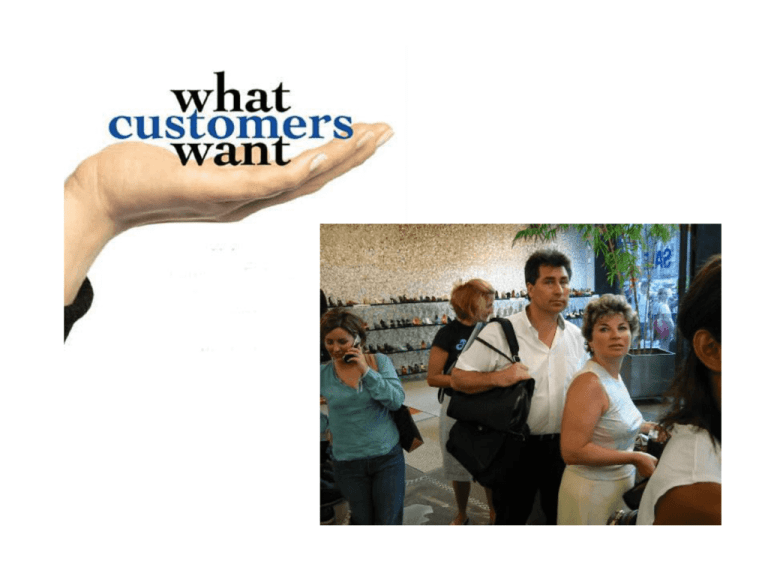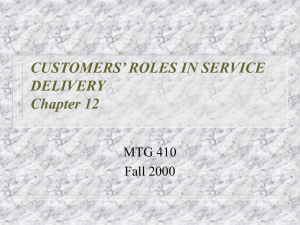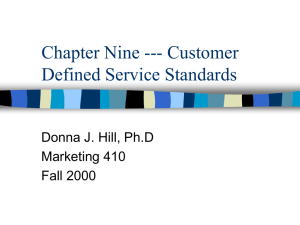Exhibit 10.1 Examples of Hard Customer
advertisement

Customer vs Company Defined Standards • Customer- defined service standards are not sufficient to bring effectiveness to an organization. • There is a place in an organization for company defined standards because these standards promote productivity and efficiency. Hard vs Soft Standards • Hard standards are operational standards • Soft standards are perceptual standards • Employees tend to accept operational standards more than perceptual standards • because they trust the measurement of operational standards to a greater degree. • Perceptual standards are considered to be subjective • and more biased than operational standards Hard Standards • Things that can be counted, timed, or observed through audits – delivery time – response time • number of times a phone rings before it is answered • on time appointments – order correctly filled – number of sales calls per month per customer Soft Standards • Standards that must be documented using perceptual measures. – Courteous – Trustworthy – Communication skills • Opinion based measures that cannot be observed and must be collected by talking to customers, employees, or others Examples of Soft Customer-Defined Standards Developing Standards • Standards are most difficult to develop in professional service. • For professional services specific, concrete and standardized behaviors can rarely be stated as standards because their service is complex and depends on the expertise of providers. • Nevertheless, some standards can be specified. Mayo Clinic Example • Every patient will be weighed and have their blood pressure checked. • Each patient must complete a personal history form. • Each patient will pay for services upon receipt. Obtaining Compliance • These particular standards would not be hard to obtain compliance for because they deal with staff rather than experts. • However, the professionals and experts would resist standards for themselves – believe their work can not be reduced to repetitive actions and behaviors. – believe their work relies on their expertise and may argue that each patient is different. • Any standards developed for experts must be shown to have value Template for Process Map for Customer-Driven Standards and Measurements Service Encounter Service Quality Customer Requirements Measurements AT&T’s Process Map for Measurements Business Process 30% Product 30% Sales Total Quality 10% Installation 15% Repair 15% Billing Source: AT&T General Business Systems Internal Metric Customer Need Reliability Easy To Use Features / Functions (40%) (20%) (40%) % Repair Call % Calls for Help Knowledge Responsive Follow-Up (30%) (25%) (10%) Supervisor Observations % Proposal Made on Time % Follow Up Made Delivery Interval Meets Needs Does Not Break Installed When Promised (30%) (25%) (10%) Average Order Interval % Repair Reports % Installed On Due Date No Repeat Trouble Fixed Fast (30%) (25%) Kept Informed (10%) % Repeat Reports Average Speed Of Repair % Customers Informed Accuracy, No Surprise Resolve On First Call Easy To Understand (45%) (35%) (10%) % Billing Inquiries % Resolved First Call % Billing Inquiries Functional Performance Test Process for Setting Customer-Defined Standards 1. Identify Existing or Desired Service Encounter Sequence 2. Translate Customer Expectations Into Behaviors/Actions 3. Select Behaviors/Actions for Standards 4. Set Hard or Soft Standards Measure by Audits or Operating Data Hard 5. Develop Feedback Mechanisms 6. Establish Measures and Target Levels 7. Track Measures Against Standards 8. Update Target Levels and Measures Soft Measure by TransactionBased Surveys 1. Identify Existing or Desired Service Encounter Sequence • Describe the service encounter – Scripts – Blueprinting 2. Translate Customer Expectations into Behaviors and Actions • Conduct marketing research to identify customer expectations • Translate expectations into concrete specific behaviors and actions – Responsiveness: phones are answered in three or fewer rings. – Access: location is open 7 days a week 3. Select Behaviors and Actions for Standards • Prioritize the behaviors and actions into those for which customer defined standards will be established. 4. Decide Whether Hard or Soft Standards are Appropriate • Hard • Soft • Both 5. Develop Feedback Mechanisms for Measurement Standards Capture the process from a customer’s point of view rather than the company’s Aligning Company Processes with Customer Expectations Customer Expectations Customer Process Blueprint Company Process Blueprint A B Lost Card Reported 48 Hours Report Lost Card Receive New Card Company Sequential Processes C D E 10 Business Days ? F G New Card Mailed H 6. Establish Measures and Target Levels • Benchmarking • Without this step a company cannot determine if the standard has been met. 7. Track Measures Against Standards • Gather data • Analyze data • Act on the information 8. Provide feedback about Performance to Employees • Service requirements must be communicated through the organization. • Determine the communication mechanisms • How frequently will information be shared? 9. Periodically Update Target Levels and Measures In order to keep up with customer expectations revise the target levels, measures, and customer requirements on a regular basis. Importance/Performance Matrix HIGH 10.0 Improve Maintain Does whatever it takes to correct problems (9.26, 7.96) Delivers on promises specified in proposal/contract (9.49, 8.51) Gets project within budget, on time (9.31, 7.84) Gets price we originally agreed upon (9.21, 8.64) Tells me cost ahead of time (9.06, 8.46) Provides equipment that operates as vendor said it would (9.24, 8.14) Completes projects correctly, on time (9.29, 7.68) 9.0 Gets back to me when promised (9.04, 7.63) Importance Takes responsibility for their mistakes (9.18, 8.01) Delivers or installs on promised date (9.02, 7.84) 8.0 LOW 7.0 8.0 Performance 9.0 10.0 HIGH Service Performance Index Service performance indexes are comprehensive composites of the most critical performance standards. – Helps the company to understand the most important requirements of the customer. – Links the service requirements to tangible and measurable aspects of the service. – Companies use feedback to identify and improve service problems. – Companies should develop reward and recognition systems based on performance. Benefits of Customer Satisfaction and Service Insulates customers from competition Can create sustainable advantage Reduces failure costs Encourages repeat patronage and loyalty Customer Satisfaction and Service Quality Enhances/promotes positive WOM Lowers costs of attracting new customers Return on Quality (ROQ) ROQ approach is based on four assumptions: 1. Quality is an investment 2. Quality efforts must be financially accountable 3. It’s possible to spend too much on quality 4. Not all quality expenditures are equally valid Implication: Quality improvement efforts may benefit from being related to productivity improvement programs Service Quality • Service quality is the customer’s judgment of overall excellence of the service provided in relation to the quality that was expected. • Process and outcome quality are both important. Evidence of Service from the Customer’s Point of View Process Operational flow of activities Steps in process Flexibility vs. standard Technology vs. human People People Contact employees Customer him/herself Other customers Physical Evidence Process Physical Evidence Tangible communication Servicescape Guarantees Technology What Customers Expect: Getting to Actionable Steps Satisfaction Relationship Dig deeper Value Solution Provider Diagnosticity: Requirements: Abstract Low General concepts Reliability Empathy Assurance Tangibles Responsiveness Price Dimensions Delivers on time Returns calls quickly Knows my industry Dig deeper Dig deeper Attributes Delivers by Wednesday Returns calls in two hours Knows strengths of my competitors Concrete Behaviors and actions High Building a Service Quality Information System • • • • • • • • • Complaint analysis Post-transaction surveys Ongoing customer surveys Customer advisory panels Employee surveys/panels Focus groups Mystery shopping Total market surveys Capture of service operating data How Customers Widen the Service Performance Gap • Lack of understanding of their roles • Not being willing or able to perform their roles • No rewards for “good performance” • Interfering with other customers • Incompatible market segments Customer Roles in Service Delivery Productive Resources Contributors to Service Quality and Satisfaction Competitors Customers as Productive Resources • customers can be thought of as “partial employees” – contributing effort, time, or other resources to the production process • customer inputs can affect organization’s productivity • key issue: – should customers’ roles be expanded? reduced? Services Production Continuum Customer Production 1 Joint Production 2 3 Firm Production 4 5 6 Gas Station Illustration 1. Customer pumps gas and pays at the pump with automation 2. Customer pumps gas and goes inside to pay attendant 3. Customer pumps gas and attendant takes payment at the pump 4. Attendant pumps gas and customer pays at the pump with automation 5. Attendant pumps gas and customer goes inside to pay attendant 6. Attendant pumps gas and attendant takes payment at the pump Customers as Contributors to Service Quality and Satisfaction • Customers can contribute to: – their own satisfaction with the service • by performing their role effectively • by working with the service provider – the quality of the service they receive • by asking questions • by taking responsibility for their own satisfaction • by complaining when there is a service failure Importance of Other (“Fellow”) Customers in Service Delivery • Other customers can detract from satisfaction: – – – – disruptive behaviors overly demanding behaviors excessive crowding incompatible needs • Other customers can enhance satisfaction: – mere presence – socialization/friendships – roles: assistants, teachers, supporters, mentors Overcoming Customers’ Reluctance to Accept Changes in Environment & Behavior • • • • • Develop customer trust Understand customers’ habits and expectations Pretest new procedures and equipment Publicize the benefits Teach customers to use innovations & promote trial • Monitor performance, continue to seek improvements Customers as Competitors • customers may “compete” with the service provider • “internal exchange” vs. “external exchange” • internal/external decision often based on: – – – – – – – expertise capacity resources capacity time capacity economic rewards psychic rewards trust control Strategies for Enhancing Customer Participation Outcomes of Customer Satisfaction • Increased customer retention • Positive word-ofmouth communications • Increased revenues





